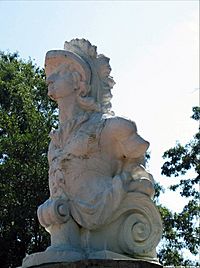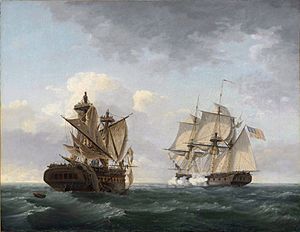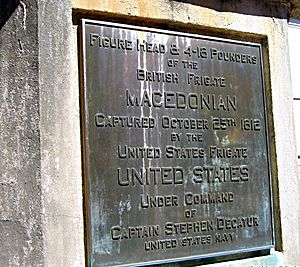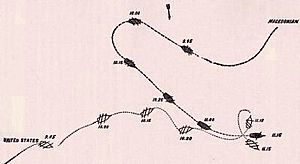Macedonian Monument facts for kids
Quick facts for kids Macedonian Monument |
|
|---|---|
| United States Naval Academy | |

Figurehead of HMS Macedonian
Campus of the US Naval Academy |
|
| For the victory of the frigate United States over HMS Macedonian 25 October 1812 | |
| Unveiled | circa 1810 |
| Location | 38°59′00″N 76°29′09″W / 38.98335°N 76.48592°W near Mahan Hall
|
| Designed by | unknown, bronze relief plaque by Edward Berge |
The Macedonian Monument is a special landmark at the United States Naval Academy in Annapolis, Maryland. It stands near Mahan Hall and Stribling Walk. The main part of the monument is a wooden sculpture. This sculpture is actually the figurehead from a British warship called HMS Macedonian.
A figurehead is a carved figure on the front of a ship. This one was captured by Captain Stephen Decatur and his American frigate, the USS United States. This happened during the early days of the War of 1812. The wooden sculpture is very old, made around 1810. It arrived at the Naval Academy in 1875. Sometimes, people also call it Alexander the Great or the Figurehead of Hans Macedonian.
What the Monument Looks Like
The Macedonian Monument is quite large. It features a wooden figurehead that looks like a bust of Alexander the Great. This figure wears a shirt with ruffles and a helmet with long feathers. The sculpture is painted white. It sits on top of a square stone base.
Each side of the stone base has a curved stone bench. A green cannon tube sticks out from each corner of the base. These cannons are real 18-pounder long guns. They were captured along with HMS Macedonian itself. On the front of the base, there is a bronze relief plaque. A relief is a type of sculpture where the figures stick out from a flat surface. This plaque shows the famous battle where the Macedonian was captured. The artist for this plaque was Edward Berge, and he created it in 1924.
Messages on the Monument
The bronze relief plaque by Edward Berge shows the battle. Over time, some details on the plaque have worn away. The image on the plaque is very similar to a famous painting. This painting is called Engagement between the "United States" and the "Macedonian". It was painted in 1813 by Thomas Birch.
On the front of the base, facing Mahan Hall, there is a large inscription. It tells the story of the battle:
Capture Of The Macedonian
THE AMERICAN FRIGATE UNITED STATES
Commodore Stephen Decatur, cruising between the Azores and Cape
Verde Islands On October 25, 1812 Was Sighted By The British Frigate
MACEDONIAN
Captain John S. Carden And The Two Ships Joined Action. A Sanguinary
Fight Was Maintained When After Two Hours The Macedonian Losing
Her Mizzenmast And Main Topmast Became Unmanageable And With
104 Casualties Out Of A Total Of 254 And Many Of Her Guns Disabled
Hauled Down Her Colors.
This inscription explains that on October 25, 1812, the American ship United States met the British ship Macedonian. A fierce fight lasted for two hours. The Macedonian was badly damaged. It lost its masts and many guns. With 104 injured or dead sailors out of 254, the British ship had to surrender.
Right below this main inscription, there is a smaller plaque:
Restored 1967
The Class Of
1925
This plaque tells us that the monument was restored in 1967. The Class of 1925 helped make this restoration possible.
On the back of the base, facing Bancroft Hall, there is another inscription:
Figurehead & 4–18 Pounders
of the
British Frigate
MACEDONIAN
Captured October 25th 1812
by the
United States Frigate
UNITED STATES
Under Command
of
Captain Stephen Decatur
United States Navy
This inscription clearly states that the figurehead and the four cannons came from the British frigate Macedonian. It also reminds us that the USS United States, led by Captain Stephen Decatur, captured them on October 25, 1812.
History of the Monument
The battle between the USS United States and HMS Macedonian was a big American victory. The Macedonian was outmatched and captured after a short fight. After its capture, it became the USS Macedonian. It served in the United States Navy until late 1828.
The ship was then taken apart at the Gosport Navy Yard in Portsmouth, Virginia. Its keel, which is the main bottom structure of a ship, was used to build a new American frigate. This new ship was also named USS Macedonian. Sometime after this, the old Macedonian's figurehead became a monument at the shipyard. In 1875, it was moved to the Naval Academy.
The monument got a big update in 2014. The old figurehead was replaced with a new one carved from mahogany wood. The benches were also replaced, and the concrete base was fixed. The cannons and plaques were cleaned and repaired. This project cost $300,000. It was a gift from the Naval Academy class of 1973. A special ceremony to rededicate the monument took place on April 25, 2014.




